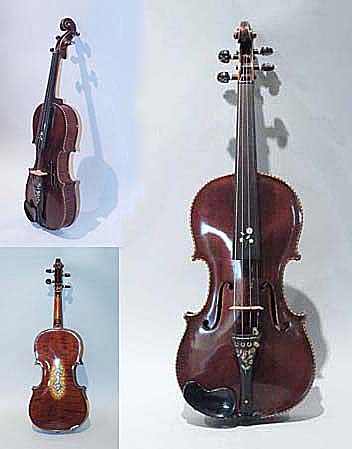
Owner: HWMC
Catalog#: 2CL-CHLT-017
Violin Family
‘C. Bruno & Son’- Bohemian/Vogtland Violin
Import from Germany
C. Bruno & Son, NY
Wood, ebony, mother-of-pearl
ca. 1880’s-1890’s
Length 23.5 in
Strings – Lutes – Violin Family
This Bohemian/Vogtland violin of the 19th century has mother-of-pearl inlay, mahogany stained wood, and a dark stained wood fretboard and neck. The fretboard has a flower design inlaid with mother-of-pearl, and the tailpiece has a similar design with a bird, in mother-of-pearl with red, green, and blue. The bridge is unlacquered wood, and there is a stylized acoustic hole on either side of the bridge. The curled scroll is worn, and the dark wooden tuning pegs are all inlaid with 4 teardrop petals surrounding a circle in mother of pearl. The chin rest is made of a black lacquered wood, attached with metal fastenings. The edges are decorated throughout with beautiful rope-like purfling. The back of the body has a small, symmetrical floral design made of mother-of-pearl with inlaid strips of dark wood resembling a mosaic. The decorated area of the body has a much lighter stain. In particular, the C. Bruno & Son catalogue identifies this violin as Fancy Violin pattern #121.
In the 19th century, the new constellation of violin making in the economic region of the border between western Bohemian and the Vogtland evolved into a highly efficient division of labor. It went on to shape the wide-scale musical culture of Europe and the United States with the large numbers of cost-effective instruments it yielded. Smaller workshops throughout the entire binational area built instruments and, more notably, instrument parts to large-volume merchants who sold them internationally at top profits. One such company in New York City was the C. Bruno & Son Music Merchant.
C. Bruno & Son was a large manufacturer of instruments in New York between 1884 and 1924. Its founder, Charles Bruno, moved from Germany to Macon, Georgia in 1832. Two years later he moved to New York and opened a bookshop which evolved into a successful distribution business of musical instruments. In particular, he imported violin-family instruments from Europe for sales in America.
Upon his death in 1884, Charles Bruno left the business to his son. The firm did make some of its own instruments, but most were just branded and sold by the shop. Bruno was an excellent entrepreneur and with his wide knowledge of music history, he was able to sell fine instruments all over the country. C. Bruno & Son became one of the largest instrument sellers in New York at the time.
Resource: https://www.corilon.com/us/library/towns-and-regions/violin-making-in-western-bohemia-and-the-vogtland-region
